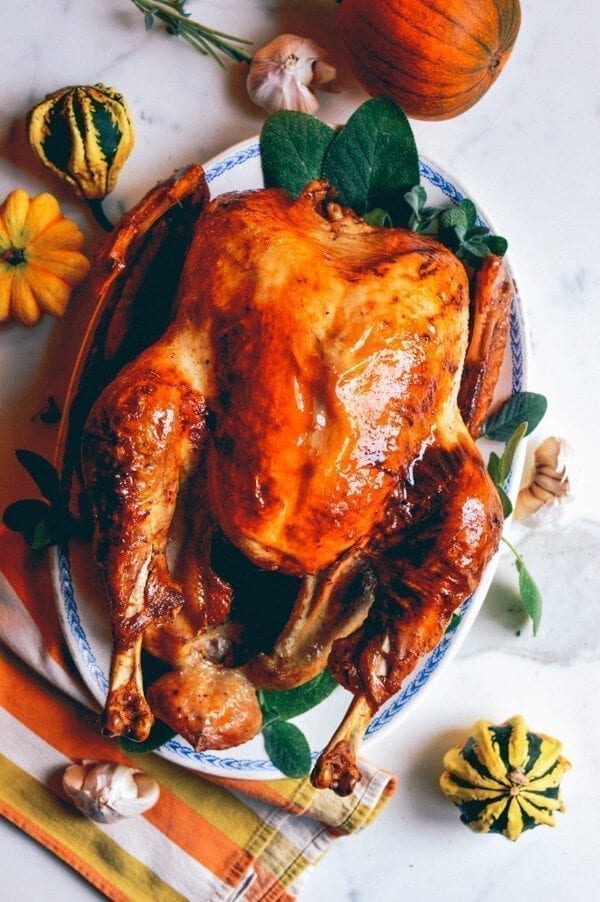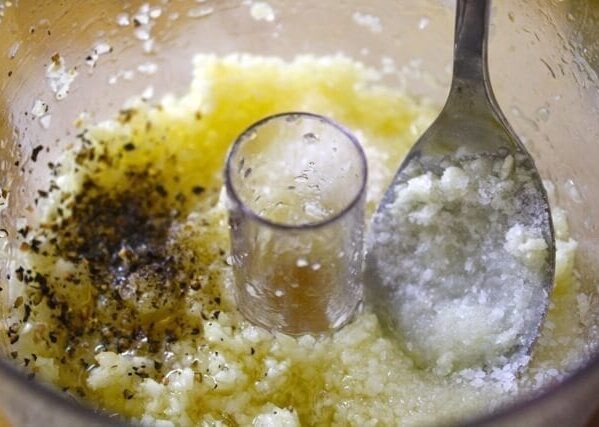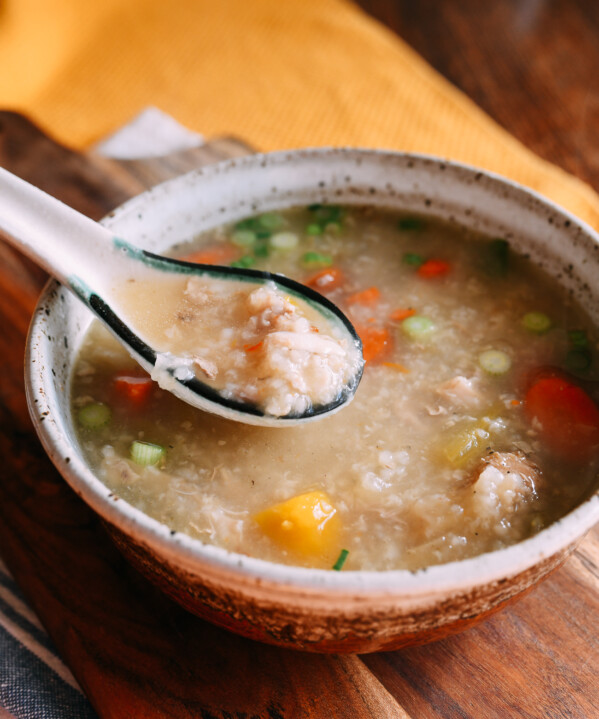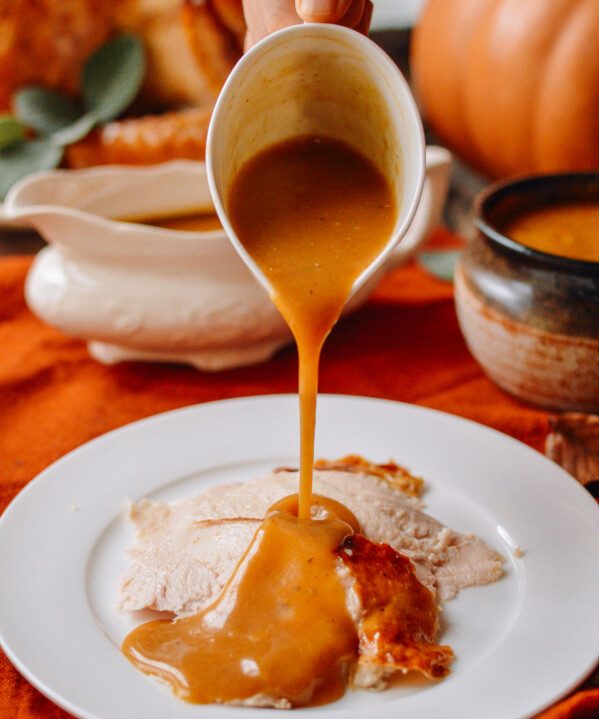This is our grandpa’s perfect Thanksgiving Turkey recipe, which we make every single year without fail. Why grandpa’s recipe? Our grandfather was a professional chef and resort hotel roast cook, so he knew a thing or two about roasting meat and poultry.
We make his Thanksgiving roast turkey recipe the same way every year. Not only is it always juicy and delicious—and still the best turkey we’ve ever had—it. is. EASY. No buckets of brine, no spatchcocking, no turkey fryer, no basters, injectors, or pop-up timers. Just an incredibly simple marinade and straightforward roasting instructions.
Since posting this recipe in 2014, it has become the go-to turkey recipe for many other families. Perhaps it will have a special place on your family’s table too.
Preparing for Thanksgiving
Thanksgiving is one of my absolute favorite holidays, for three big reasons:
1. It involves my favorite meal of the year (…Top 5 at least).
2. It heralds the start of nonstop Christmas music on the radio. Because I’m a weirdo who never gets tired of Perry Como and Nat King Cole singing about chestnuts on open fires/the only person on earth who still listens to the radio.
3. Pie. Thanksgiving is by far, the biggest of the pie holidays.
As the big day approaches, the time comes to start thinking about cooking your bird. I’ve always been a bit puzzled by people making such a huge deal out of their Thanksgiving turkeys. I mean…turkey help hotlines? Electric meat saws? Waking up at 6am to put it in the oven?
It’s all a little too much.
Why We Make THIS Recipe Every Year
For as long as I can remember, this has been the Thanksgiving turkey recipe prepared in our house every Thanksgiving. My grandfather, a chef by trade, would use this method to roast chickens at the restaurant he worked in, and for turkey every holiday season.
He passed the recipe down to my parents, and they let my sister and me in on the secret of how to cook a turkey perfectly.
This Thanksgiving turkey recipe requires no large plastic tubs, surgical gloves, brining spices, or deep fat fryers. You don’t even need many ingredients.
There’s no complex preparation in advance, beyond whipping up a quick marinade in the food processor (the recipe works just as well with a regular knife and cutting board too), and it’s always awesome. The main flavor agents are garlic and salt, but you really don’t get a strong garlicky flavor after it’s cooking. It’s super mellow, really juicy and hands down, the best roast turkey we have had.
The “Dry Brine” Trend
We’re updating this recipe in 2024 with a video showing you how we roast this turkey. You may have heard the term “dry brining” bandied about on various food publications, touted as the MOST AMAZING WAY TO PREPARE TURKEY!!
I ask you: When did a simple overnight marinating with some salt and spices become “dry brining?” SIGH. Even for us food bloggers, the food trends can get a little exhausting. Let it be known that our grandpa was “dry brining” turkey in the 70s—before it was even called that!
A Simple Marinade
The marinade for this turkey consists of 5 ingredients:
- fresh garlic
- salt
- pepper
- olive oil
- butter

I mean, how simple are those ingredients? You probably have everything you need to season this turkey in your kitchen RIGHT NOW.
The truth is, you don’t need much to make sure your turkey has lots of flavor. Salt brings out the flavor of the turkey, while the garlic and pepper add a little zip. (In case you’re worried, this turkey doesn’t taste “garlicky.” It just tastes delicious.)
Finally, the olive oil and butter help to create a paste for the marinade and crisp up the skin.
While we have other turkey recipes (see our Honey Glazed Cantonese Turkey, Herb Roasted Turkey Breast, and Five Spice Roast Turkey), which are all very good (go for the turkey breast if you’re hosting a smaller gathering!), we continually return to this one on Thanksgiving, because it just…distills that essence of *turkey* and is dang tasty to boot.
What Size Turkey Should I Get?
The general rule of thumb is 1.25-1.5 pounds of turkey per person, depending on your guests’ appetites and the number of sides you have. It also depends on whether or not you care about having leftovers to make things like sandwiches, turkey noodle soup, or Next-Day Thanksgiving Pastries.
More sides? Err on the lower side of the range. Making a simpler dinner where the turkey is really the star? Go for the higher end.
So if you’re having 10 people for dinner, a 13-15 pound turkey should get the job done.
That said, if you’re having a large crowd for dinner, you have a choice to make. Do you buy a 22-pound giant bird? Or do you attempt to roast two turkeys?
In our opinion, a 12-14 pound turkey is the perfect size for roasting. The bird cooks more evenly and quickly at that size, reducing your risk of dry meat.
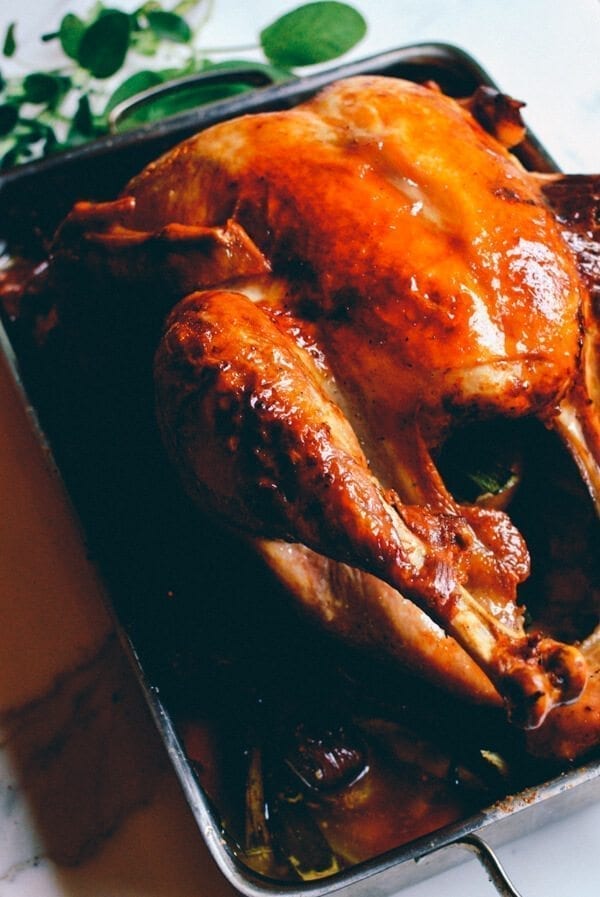
A bigger turkey simply has to stay in the oven longer, which results in some parts being juicier, and other parts being drier—or perhaps undercooked! The larger turkey also sits closer to the heating elements in your oven—another cause of dry meat. The upper limit for us is around 15 pounds.
If you’re having a large crowd of say, 15-20 people, we recommend getting two 12-13 pound turkeys rather than one big one, if you have the oven space.
Only one oven? Another alternative would be to cook one turkey in the oven and one in your outdoor BBQ grill, if you have one.
We did this one year when we had 20 people over for Thanksgiving, and it worked a treat. Just keep your heat steady in the grill, use a separate thermometer if you’re not sure the thermometer on your grill is accurate, and rotate the roasting pan 180° a couple times to help with even cooking.
Ok, I’ve talked quite enough. If you’re looking for Thanksgiving sides and desserts, be sure to check out our collection of Holiday season and Thanksgiving recipes. Onward!
Grandpa’s Perfect Thanksgiving Turkey: Recipe Instructions
3-5 days before roasting (depending on the size of your turkey), start thawing your turkey in the refrigerator. Budget about 1 day of thawing time for every 5 pounds, so a 15 pound turkey would take around 3 days.
NOTE: This means you will have to buy your turkey several days before Thanksgiving. Don’t wait until the last minute!

(If your turkey isn’t completely thawed the night before roasting, you can finish the thawing process in cold water, changing the water every 30 minutes. Be sure to return it to the refrigerator right after marinating.)
On the day before you plan to roast it, make the marinade by combining the garlic, salt, black pepper, olive oil, and butter in the food processor. Pulse until you have a very fine paste.

Put your carrots, celery, and onions on the bottom of your roasting pan. This will be the roasting “rack” that your turkey will sit on.

Remove the turkey from the package. Remove the neck and the giblets from the turkey cavity and give the bird a good rinse with cold water. Pat it thoroughly dry with paper towels, and lay it breast side down in the pan.
Rinsing TUrkey
Before you come after us for rinsing poultry, let us say: you are the boss in your own kitchen, and you can skip this step.
However, we will always rinse our turkey (and yes, disinfect the sink and area around the sink afterwards. Remove any sponges, soap containers, or anything else from around your sink area before doing this, and thoroughly disinfect after you’re done.)
Rinsing the cavity of any lingering blood, slimy membranes, or organs will ultimately result in a better tasting bird (and a cleaner turkey stock for congee afterwards). Chinese people always rinse their meat for this reason. We talked about it in this Food Network article if you’d like to read more.
Ok, so before I go any further, you may have noticed that we didn’t say anything about removing the turkey tail. This KILLS me as I veg out on the couch watching Food Network Thanksgiving specials. The turkey tail is always mysteriously missing. Is this a regular thing? People wantonly chopping off the turkey tail for aesthetic reasons? It’s malarkey!
My nose-to-tail philosophy and general Asian street cred compel me to say: do. not. throw. away. the. tail.
Just trust me on this.
Ok, so spread half of your marinade all over the back side of the turkey, making sure you cover every surface and crevice, including the cavity. Flip the bird over so it’s laying breast side up, and spread the other half of the marinade over this side of the turkey.
You can also spread some marinade over the neck and the giblets and add them to the roasting pan as well.

Cover the roasting pan with plastic, and allow to marinate overnight.
FLIPPING TURKEY
You’ll notice that we’re flipping this bird a few times in this recipe. There are reasons for this.
- It’s best to marinate the turkey breast side up, since this is the turkey’s “good side” that will be presented at the table. Marinating breast side down on the bed of vegetables may result in unsightly indentations in the breast meat.
- However, the turkey will start cooking breast side down and then get flipped breast side up to finish cooking, so that the turkey’s “good side” is up when the turkey comes out of the oven to be served!
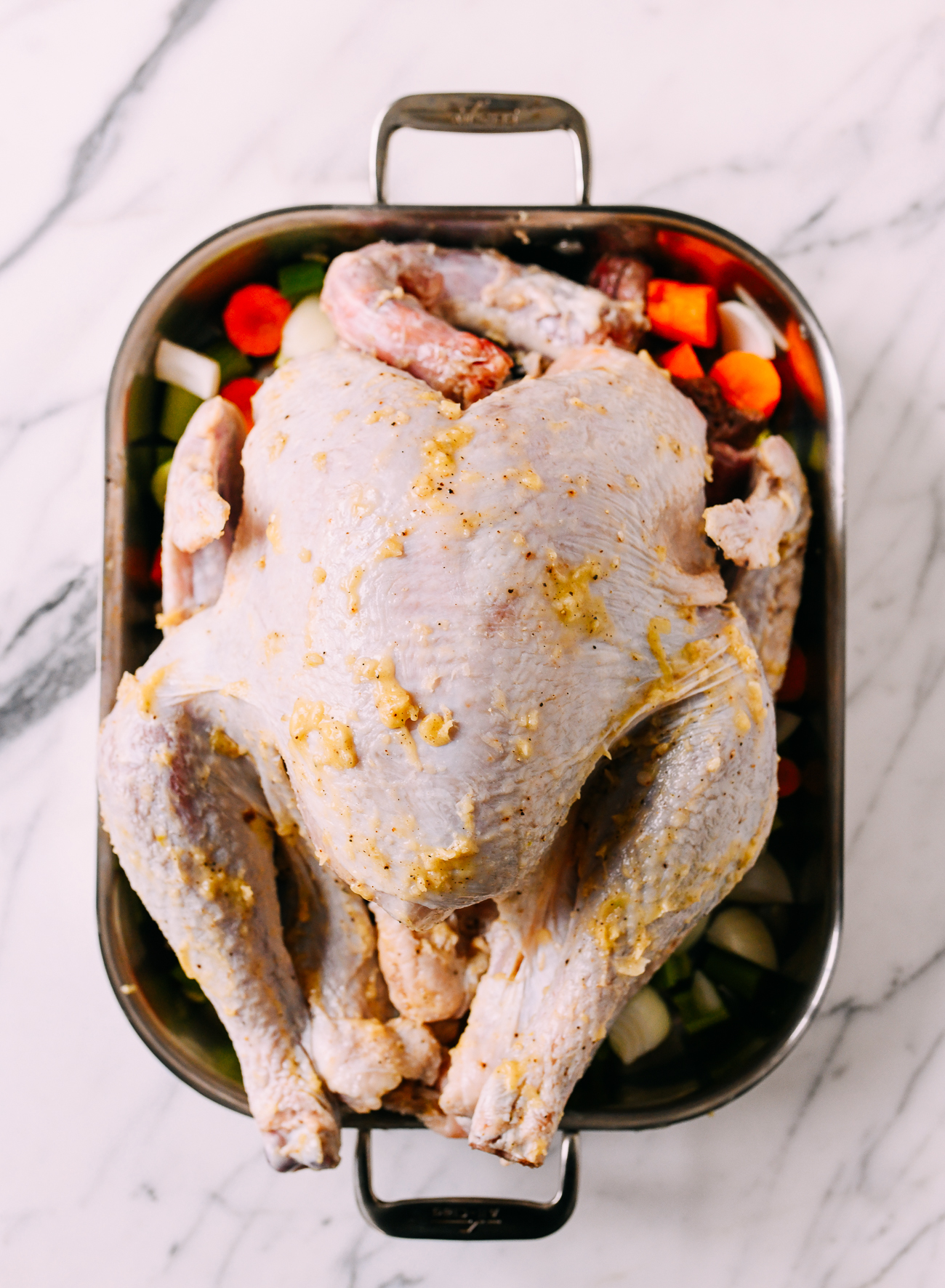
On the morning of the big day, take the turkey out of the fridge and let it sit on the counter (so you’re not putting a cold turkey directly into the oven, which can prevent it from cooking evenly). About 3 hours before you’re ready to eat, preheat the oven to 425°F/220°C, and arrange the oven rack so it’s in the lower third of the oven. Take the plastic off your roasting pan and lift up the turkey to empty any liquid that might have accumulated in the cavity as it sat out on the counter. Flip your turkey breast side down. Make sure the wings are tucked in, and roast at 425°F/220°C for 1 hour, rotating the pan halfway through.

Remove the turkey from the oven and lower the temperature to 325°F/160°C. Using a sturdy wooden spoon and a paper towel or clean kitchen towel, flip the turkey breast-side up. It will look pale—this is ok. It will get nice and golden as it finishes roasting!


Roast the turkey at the lower temperature for another hour (for a 12-pound turkey) to an hour and a half (for a 14-pound turkey), until the thigh registers 165°F and the juices run clear (i.e. not pink). Rotate the pan halfway through the second roasting process as well.
Roasting Times & Tips for Different Sized Turkeys
Again, we think a 12-15 pound turkey is the perfect size—it cooks quickly and evenly, and you have a good chance of both the thighs and breast finishing at the same time for juicy dark AND white meat.
If, however, you have a larger or smaller turkey, here are approximate roasting times.
| Turkey Weight | Roasting Time Breast-Side Down at 425°F/220°C | Roasting Time Breast-Side Up at 325°F/160°C | Total Roasting Time |
| 12 to 14 pounds (5.4-6.4 kg) | 1 hour | 1 to 1.5 hours | 2 to 2.5 hours |
| 15 to 17 pounds (6.8-7.7 kg) | 1 hour | 1.5 to 2 hours | 2.5 to 3 hours |
| 18 to 22 pounds (8.1-10kg) | 1 hour | 2 to 2.5 hours | 3 to 3.5 hours |
For instance, for an 18-pound turkey, you would roast for 1 hour breast-side-down at 425°F/215°C and then flip the turkey breast-side-up and roast at 325°F/160°C for 2 hours, for a total of 3 hours.
Important Notes:
- Be sure to increase or decrease marinade ingredients proportionally to any changes in turkey size. Click on the serving # in the recipe card below to scale the recipe up or down according to the weight of your turkey.
- Remember to rotate the roasting pan 180° halfway through the first hour of cooking, and then again halfway through the cooking time at 325°F/160°C. This will help ensure even cooking.
- If you’re cooking a larger turkey, tent the breast lightly with foil after it has turned golden brown, so it stays moist even with the extended cooking time.
- Towards the end of your estimated cooking time, it’s a good idea to test your turkey temperature with an instant-read thermometer inserted in the thickest part of the thigh, to prevent even slight overcooking!
Remove your Thanksgiving turkey from the oven, transfer to a carving board or serving plate, cover loosely with foil, and allow to rest for 20-30 minutes before carving.
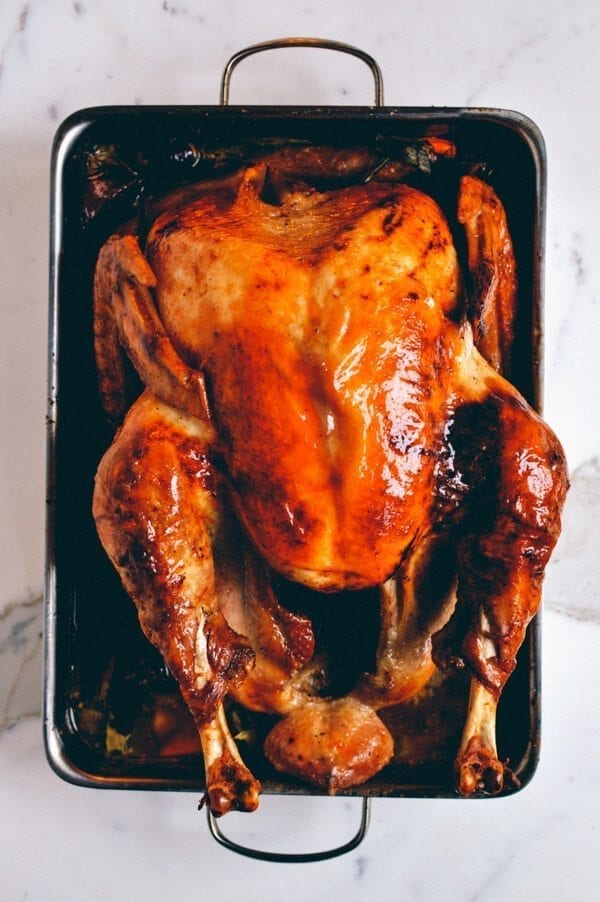
Now, we know everyone has their own method for gravy, but here’s ours: tip all the drippings from the roasting pan into a gravy separator. You want about 10 tablespoons of fat and 6 cups of the juices. If you don’t have enough of either, you can add butter (if you need more fat) and chicken stock (if you don’t have enough juice).
In a large saucepan over medium heat, add the turkey fat and/or butter. Gradually stir in enough flour to make a roux, whisking constantly. Continue whisking until the roux turns a dark brown color, about 10 minutes. Slowly whisk in the turkey juices and/or broth. Season with salt and black pepper to taste. Simmer until thickened (when it coats the back of a spoon, it’s perfect). If it’s too thick, add more broth or water. And that’s it!
See our Turkey Gravy recipe for way more detail and a couple variations!
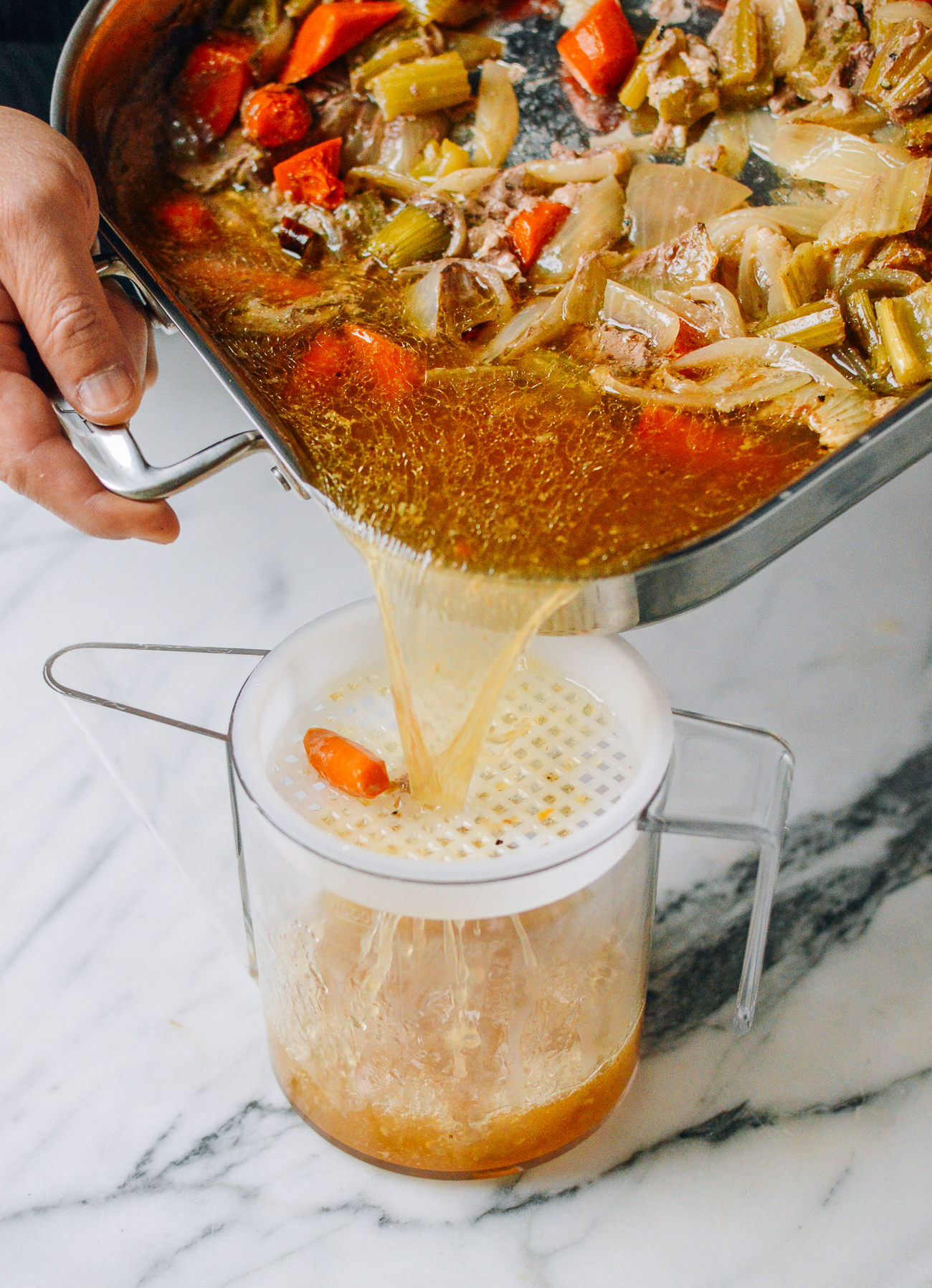
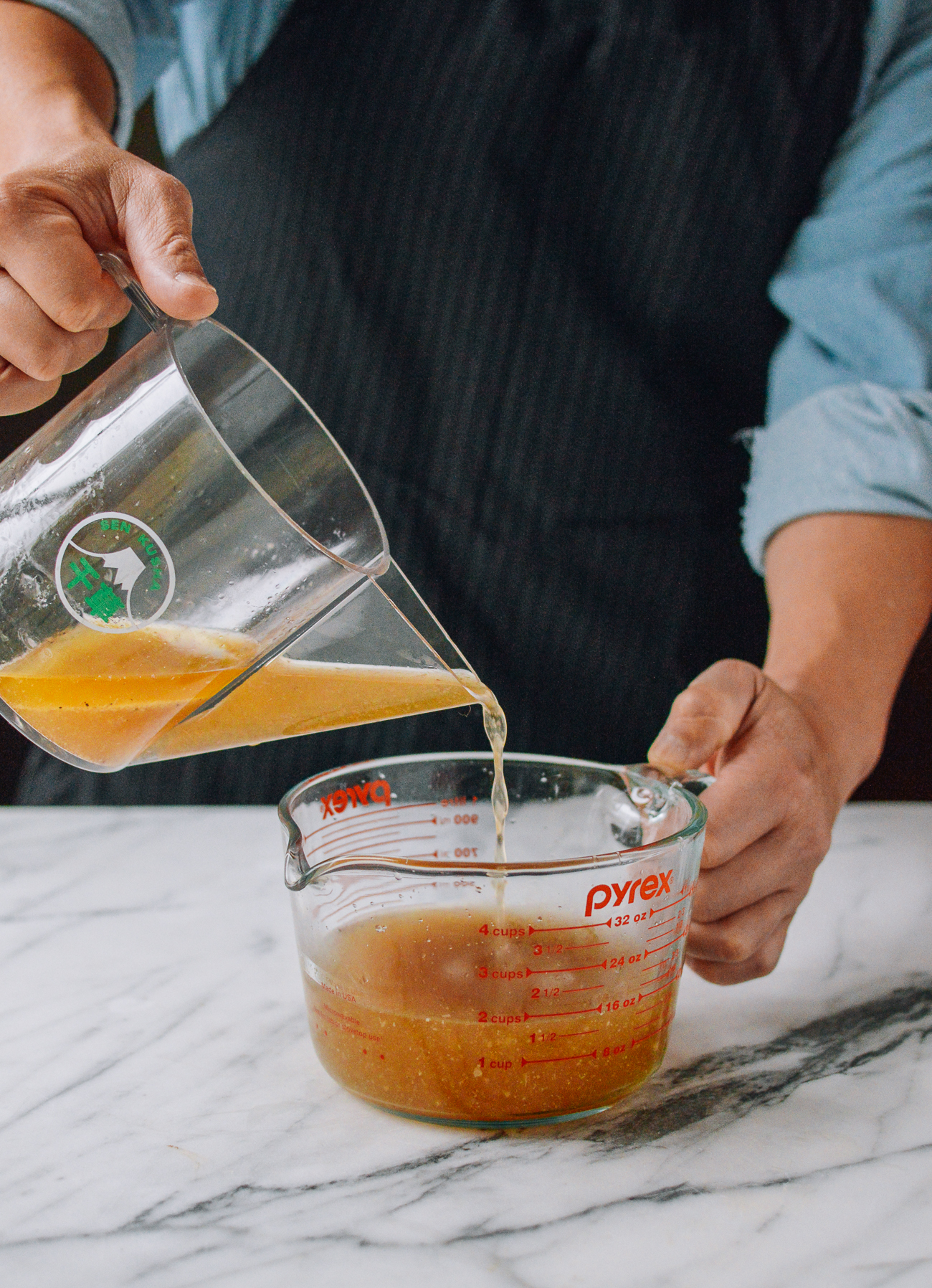
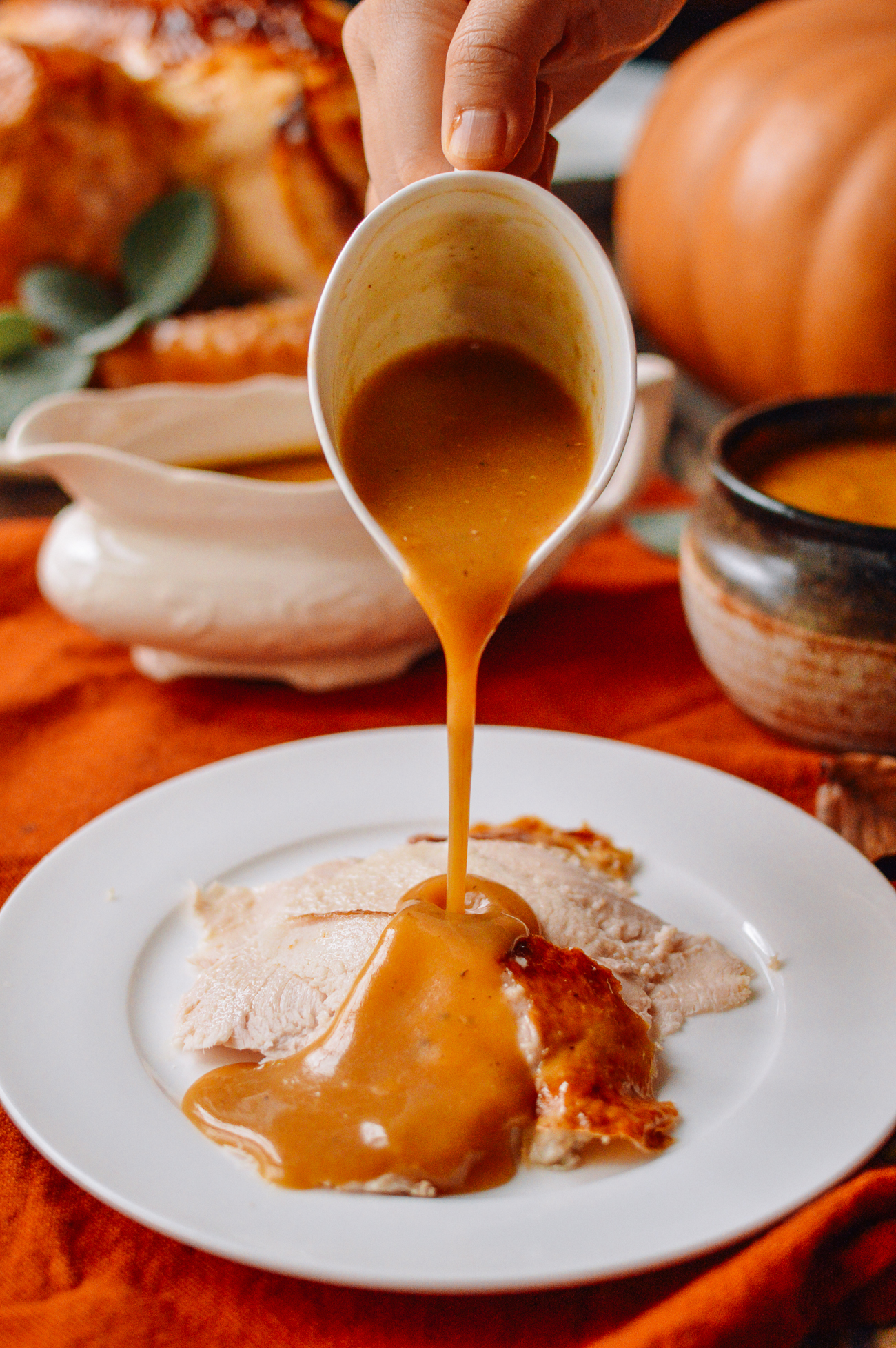
This is the Thanksgiving turkey recipe that we always make, and it turns out perfectly every time. Plus, that turkey tail? Kaitlin and my dad fight over it every year. Every. Year. And then they just end up cutting it in half, and all is well with the world.
Happy almost Thanksgiving everyone!
Behind-the-scenes note: we made this Thanksgiving turkey in September to prepare for this very post. #doublethanksgiving #foodbloggerperks #AWESOME.
Oh, and one last point about your turkey. Keep the turkey carcass for the next day to make our Leftover Turkey Congee or a satisfying Leftover Turkey Ramen!
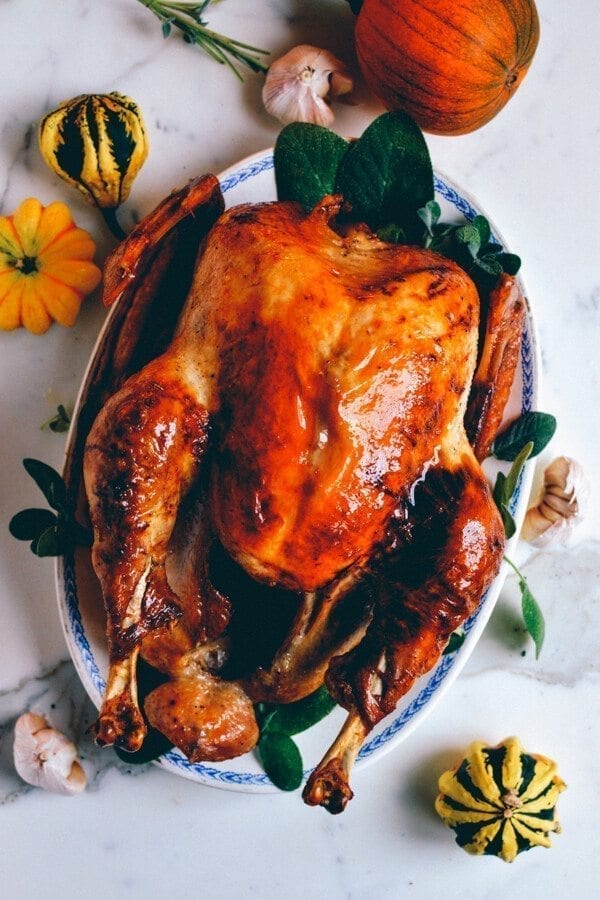
Grandpa’s Perfect Thanksgiving Turkey Recipe
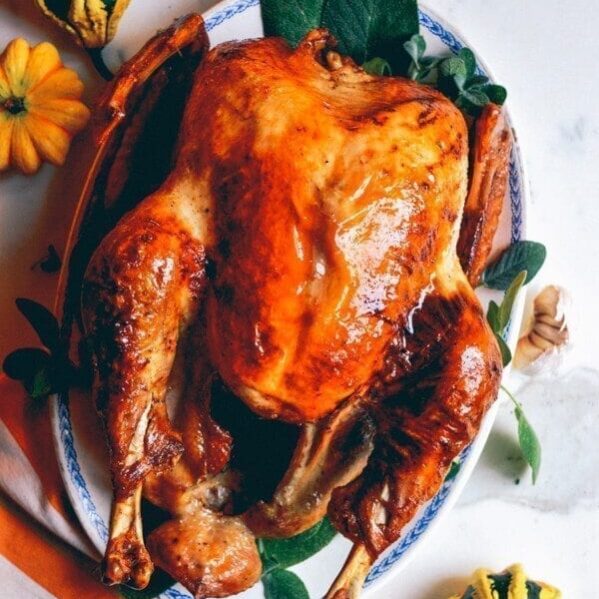
Ingredients
Instructions
- 3-5 days before roasting (depending on the size of your turkey), start thawing your turkey in the refrigerator. Budget about 1 day of thawing time for every 5 pounds. On the day before you plan to roast it, make the marinade by combining the garlic, salt, black pepper, olive oil, and butter in the food processor. Pulse until you have a very fine paste.
- Put your carrots, celery, and onions on the bottom of your roasting pan. This will be the roasting "rack" that your turkey will sit on.
- Remove the turkey from the package. Remove the neck and the giblets from the turkey cavity and give the bird a good rinse with cold water. Pat it thoroughly dry with paper towels, and lay it breast side down in the pan.
- Spread half of your marinade all over the back side of the turkey, making sure you cover every surface and crevice, including the cavity. Flip the bird over so it's laying breast side up, and spread the other half of the marinade over this side of the turkey. You can also spread some marinade over the neck and the giblets and add them to the roasting pan as well. Cover the roasting pan with plastic and marinate overnight.
- On the morning of the big day, take the turkey out of the fridge and let it sit on the counter (so you're not putting a cold turkey directly into the oven, which can prevent it from cooking evenly). About 3 hours before you're ready to eat, preheat the oven to 425°F/220°C, and arrange the oven rack so it's in the lower third of the oven. Take the plastic off your roasting pan and lift up the turkey to empty any liquid that might have accumulated in the cavity as it sat out on the counter. Flip the turkey breast side down, and make sure the wings are tucked in. Roast the turkey breast side down at 425°F/220°C for 1 hour, rotating the pan halfway through.
- Remove the turkey from the oven and lower the temperature to 325°F. Using a sturdy wooden spoon and paper towels or a clean kitchen towel, flip the turkey breast-side up. Roast the turkey at the lower temperature for another hour (for a 12 pound turkey; see note for larger turkey cooking times), until the thigh registers 165°F and the juices run clear (i.e. not pink). Rotate the pan halfway through the second roasting process as well.
- Remove the turkey from the oven, transfer to a carving board or serving plate, cover loosely with foil, and allow to rest for 20-30 minutes before carving.
- Now, we know everyone has their own method for gravy, but here’s ours: tip all the drippings from the roasting pan into a gravy separator. You want about 10 tablespoons of fat and 6 cups of the juices. If you don’t have enough of either, you can add butter (if you need more fat) and chicken stock (if you don’t have enough juice). In a large saucepan over medium heat, add the turkey fat and/or butter. Gradually stir in enough flour to make a roux, whisking constantly. Continue whisking until the roux turns a dark brown color, about 10 minutes. Slowly whisk in the turkey juices and/or broth. Season with salt and black pepper to taste. Simmer until thickened (when it coats the back of a spoon, it’s perfect). If it’s too thick, add more broth or water. That’s it!
Tips & Notes:
| Turkey Weight | Roasting Time Breast-Side Down at 425°F/220°C | Roasting Time Breast-Side Up at 325°F/160°C | Total Roasting Time |
| 12 to 14 pounds (5.4-6.4 kg) | 1 hour | 1 to 1.5 hours | 2 to 2.5 hours |
| 15 to 17 pounds (6.8-7.7 kg) | 1 hour | 1.5 to 2 hours | 2.5 to 3 hours |
| 18 to 22 pounds (8.1-10kg) | 1 hour | 2 to 2.5 hours | 3 to 3.5 hours |
